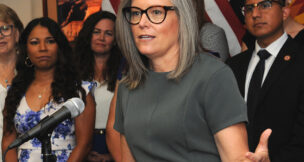Protecting flows of Colorado River protects local economies
By the very nature of a desert climate, much of the West is challenged to get adequate access to life-giving water. Certainly with the ballooning population growth we’ve experienced in the Southwest, our largest source of water — the Colorado River — has become severely over extended. Add climate change and an 11-year drought, and the entire Colorado River basin is under siege like never bef[...]
Protect clean air, develop clean energy
By supporting a transition to new, clean energy projects in our state and ensuring that existing coal plants reduce their pollution, we can restore and protect the clean air and scenic views that attract visitors to the Grand Canyon, Petrified Forest, and other now-polluted parks in the region.
Challenge to Grand Canyon mining ban clears first congressional hurdle
A proposal to reverse a federal ban on new mining claims near the Grand Canyon survived a committee vote Tuesday and could go to the full House as early as next week.
Building the Kaibab Bridge, 1921
The Kaibab suspension bridge over the Colorado River was to link Bright Angel Trail on the South Rim of the Grand Canyon with the Kaibab Trail on the North Rim. At the time, the only means of crossing the river between the two trails was by small canvas boat. (The closest ferry crossings were at Lee’s Ferry, upstream near the Utah border and downstream at Needles on the California border.) Const[...]
Ban on mining claims near Grand Canyon extended
The Interior Department has extended a temporary ban on the filing of new mining claims near the Grand Canyon with an eye toward protecting 1 million acres and giving the federal government more time to study the economic and environmental effects of mining.
Interior secretary Ken Salazar visits Grand Canyon
Interior Secretary Ken Salazar is scheduled to visit the Grand Canyon on Monday and could announce changes for mining claims near the park.
Tribal leaders testify on role of Ariz. coal plant
Two congressional subcommittees are holding a joint hearing Tuesday on the role of a coal-fired power plant on the Navajo Nation.
Federal plan to close land won’t end uranium mining near Grand Canyon
Deep within the canyon, a few miles removed from the mule trains of the popular Bright Angel Trail, Horn Creek creates a ribbon of green vegetation here before plunging toward the Colorado River.
But the handful of people allowed to camp in this splendid isolation receive a warning with their permits: Don’t drink the water when Horn Creek is flowing. It’s radioactive.
As public universities hike tuition, private Grand Canyon University stands pat
At Arizona’s public universities, incoming resident students will pay from $8,474 to $9,716 a year in tuition and fees come fall thanks to state funding cuts. That’s an increase of 45 percent to 72 percent since the 2008-2009 school year, depending on the university.
But at Grand Canyon University, a private Christian institution, tuition, while higher at $16,500 a year, isn’t changin[...]
Brewer won’t keep Grand Canyon open during shutdown
If a federal government shutdown closes Grand Canyon National Park, Gov. Jan Brewer won’t follow the playbook of her predecessor, who vowed keep the park open with state resources – and National Guard troops – if necessary.
Government shutdown would mean financial hit for Grand Canyon tourism
For businesses in Flagstaff, a city surrounded by national parks and monuments that draw tourists from all over the world, the possibility of a shuttered Grand Canyon National Park is hard to swallow.
Grand Canyon could close due to federal shutdown
Park Service rangers mounted horses, jumped aboard motorized rafts, and set out on foot and in helicopters to clear visitors from the Grand Canyon. They searched backcountry and rafting permits to find visitors throughout the 1.2 million-acre park and told them they had to leave within 48 hours.






